Dashword is a solid entry-level tool for creating SEO content. Its clean interface, keyword prompts, and simple scoring make it easy for writers to stay aligned with search intent.
But as strategies grow, many teams find it limiting, impacting their ability to generate organic traffic . There’s no support for content clusters, no internal linking, and little in the way of automation or performance tracking.
That’s why marketers start looking for alternatives—SEO optimization platforms that not only speed up briefs and drafts but also help content rank, scale, and stay competitive as search evolves.
Here are the top 10 Dashword alternatives to consider when you’re ready to take your content optimization further.
1. Surfer
Surfer is a full-stack content optimization platform that bridges the gap between writing and rankings.
Where Dashword offers lightweight briefs and keyword prompts, Surfer expands that foundation into a complete workflow with advanced features —covering planning, writing, optimization, internal linking, and even monitoring visibility in emerging AI-driven search engines.
Main features:
- Content Editor with real-time keyword, structure, and topical coverage guidance
- Content Score validated with a 0.28 correlation to rankings
- Auto-Optimize & Coverage Booster for one-click improvements to drafts
- Internal linking automation powered by Google Search Console data.
- Topical Maps to plan clusters and build topical authority at scale
- Content Audit for refreshing underperforming pages
- AI Tracker to monitor visibility across Google AI Overviews, ChatGPT, and Perplexity
Surfer’s strength is that it doesn’t just flag issues—it helps you implement fixes directly inside the editor.

The validated Content Score also sets it apart: unlike Dashword’s simpler scoring system, Surfer’s score has been shown to align closely with ranking outcomes, giving writers and strategists actionable insights and a reliable benchmark for when a piece is ready to compete.
Features like Auto-Optimize and Coverage Booster eliminate hours of manual tweaking, while the internal linking engine closes gaps across your site structure automatically.

Surfer enables users to monitor keyword rankings and track them over time, helping you identify issues and measure progress.
The platform does lean into on-page optimization rather than being an all-in-one SEO platform—so if you need backlink tracking or deep technical audits, you’ll still want to pair it with other SEO tools.
For content-focused teams, Surfer provides a direct line between what’s being written and what actually ranks.
Surfer also offers a user friendly interface and intuitive interface that make it accessible for content teams of all experience levels to create effective seo content .
We’re also one of the first platforms to address the shift toward AI search, giving teams visibility beyond Google’s classic SERPs.
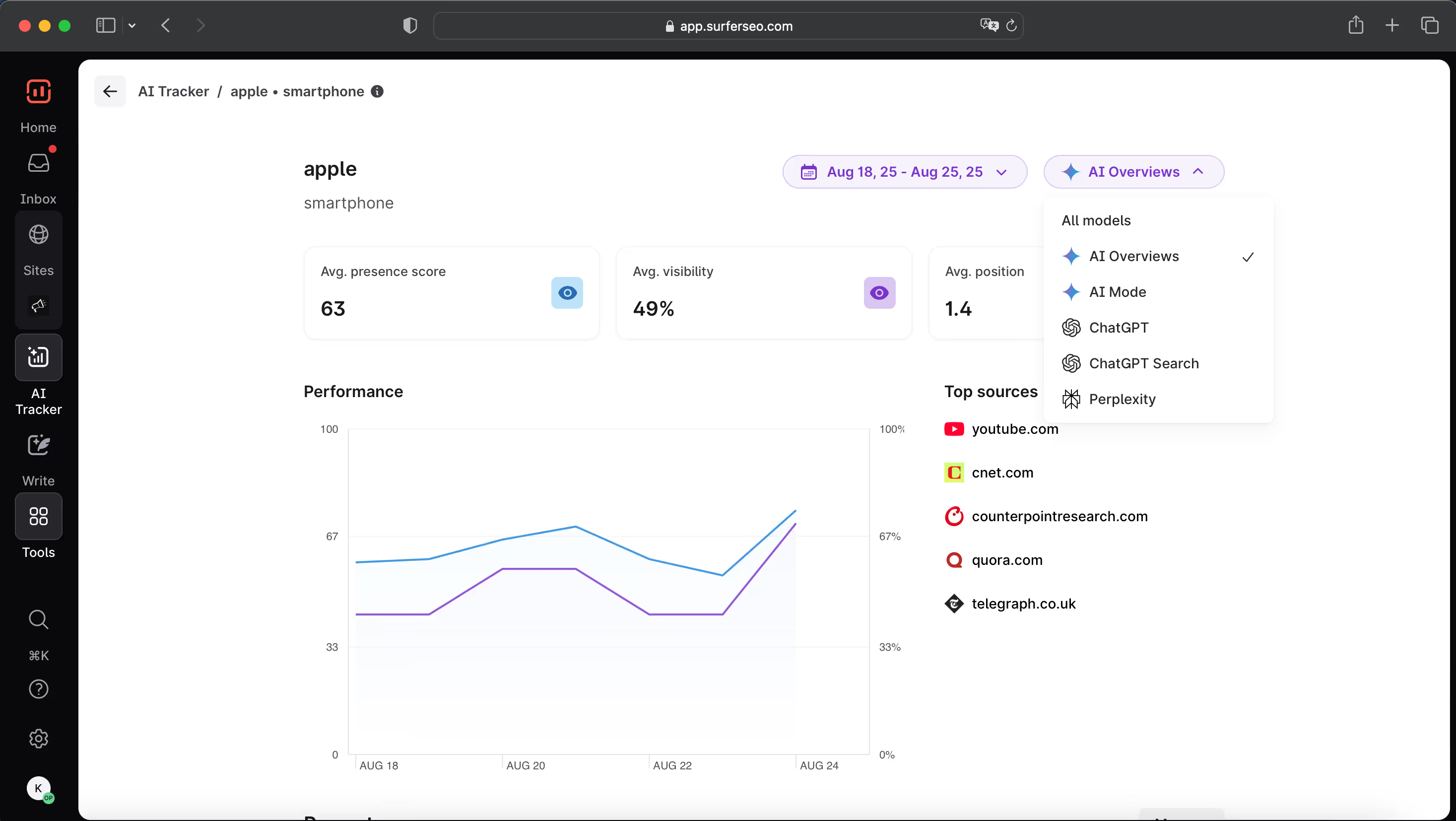
Best for: Teams that want to scale content production while tying optimization directly to measurable SEO success, both in traditional rankings and AI-driven search results.
2. Frase
Frase is designed to help writers move quickly from keyword to outline to draft, making it popular with freelancers and smaller teams that prioritize speed over complex workflows.
Compared to Dashword, it follows a similar “lean and guided” philosophy but pushes harder on quick SERP-to-brief automation and getting you to a workable first draft fast.
Main features:
- SERP analysis that extracts headings, questions, and common entities from top-ranking pages
- Auto-generated briefs and structured outlines
- In-editor content scoring with keyword and topical coverage prompts
- AI writing assistant for intros, FAQs, or section rewrites
- Functions as an AI writing tool for content creators, supporting various writing styles and needs
If Dashword helps you organize what to cover, Frase goes a step further by assembling a draftable outline with fewer manual hops.
Its content brief generator streamlines the content creation process, providing actionable data and identifying missing subtopics to optimize for search rankings.
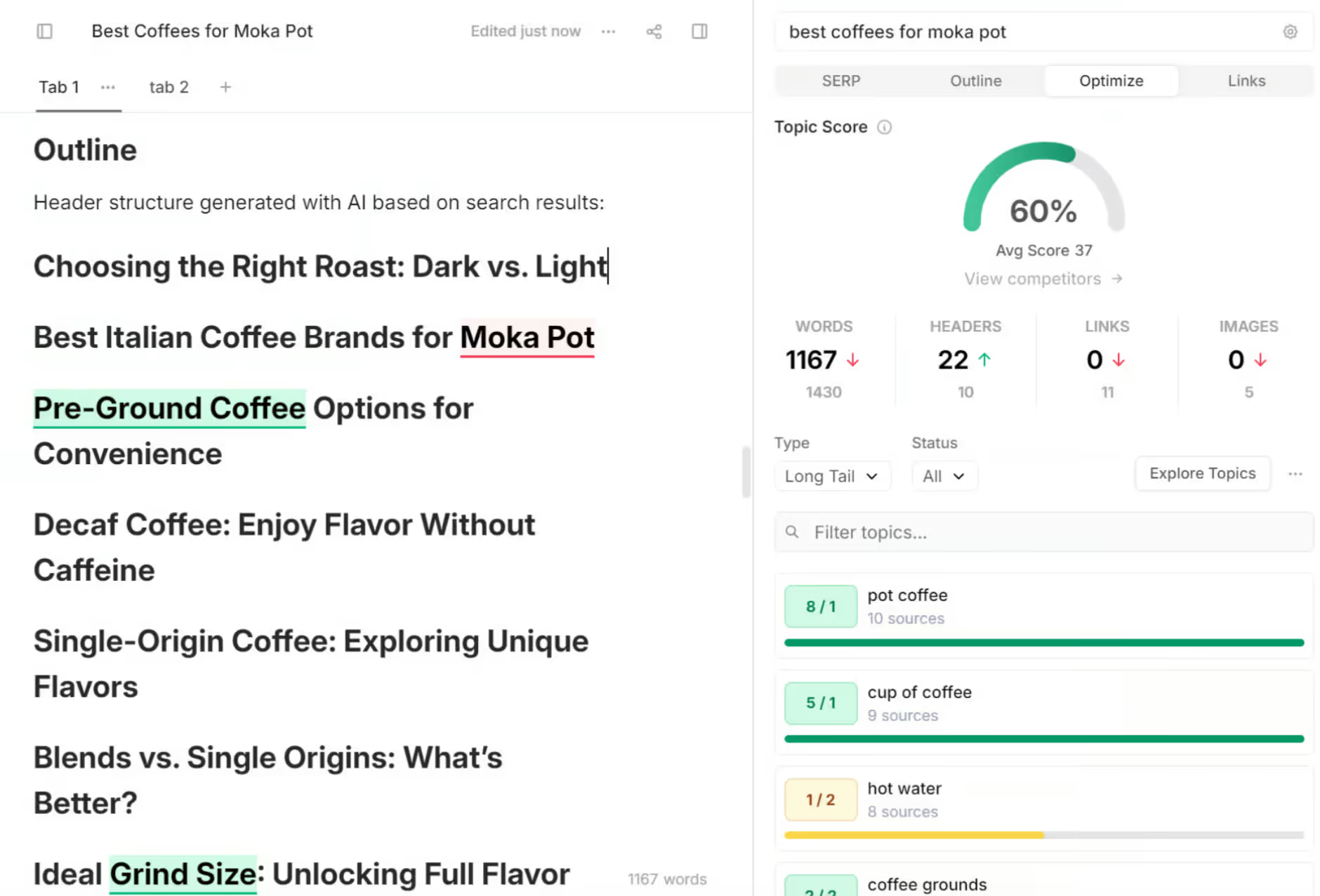
That said, the simplicity cuts both ways: once you’re managing a team, content hubs, or refresh cycles, you’ll feel the lack of deeper workflow pieces—no robust topical mapping, limited collaboration/organization, and no automated internal linking or post-publish audit flows.
Treat the score as helpful guardrails, not a proxy for rankings, and plan to pair Frase with tools that handle interlinking, content audits, and cluster strategy if growth is the goal.
Best for: Solo creators and lean teams that want faster briefs and quick first drafts than Dashword can deliver, without taking on an all-in-one suite.
3. MarketMuse
MarketMuse leans into content intelligence and strategy more than day-to-day drafting.
Compared to Dashword’s lean editor and quick briefs, it’s built to map your entire topic space, expose gaps, and provide in depth analysis on what to create next and what to refresh for the biggest upside.
Main features:
- Content inventory that audits your site and prioritizes pages to update or expand
- Topic modeling with related terms, subtopics, and questions to deepen coverage
- AI content briefs with structured headings, questions, and competitive insights
- SERP X-Ray / Topic Navigator for granular analysis of what ranks and why
- Heatmaps that visualize competitor coverage across supporting topics
If Dashword is great at “what should this single article include?”, MarketMuse answers “what should our whole library include, and in what order?”
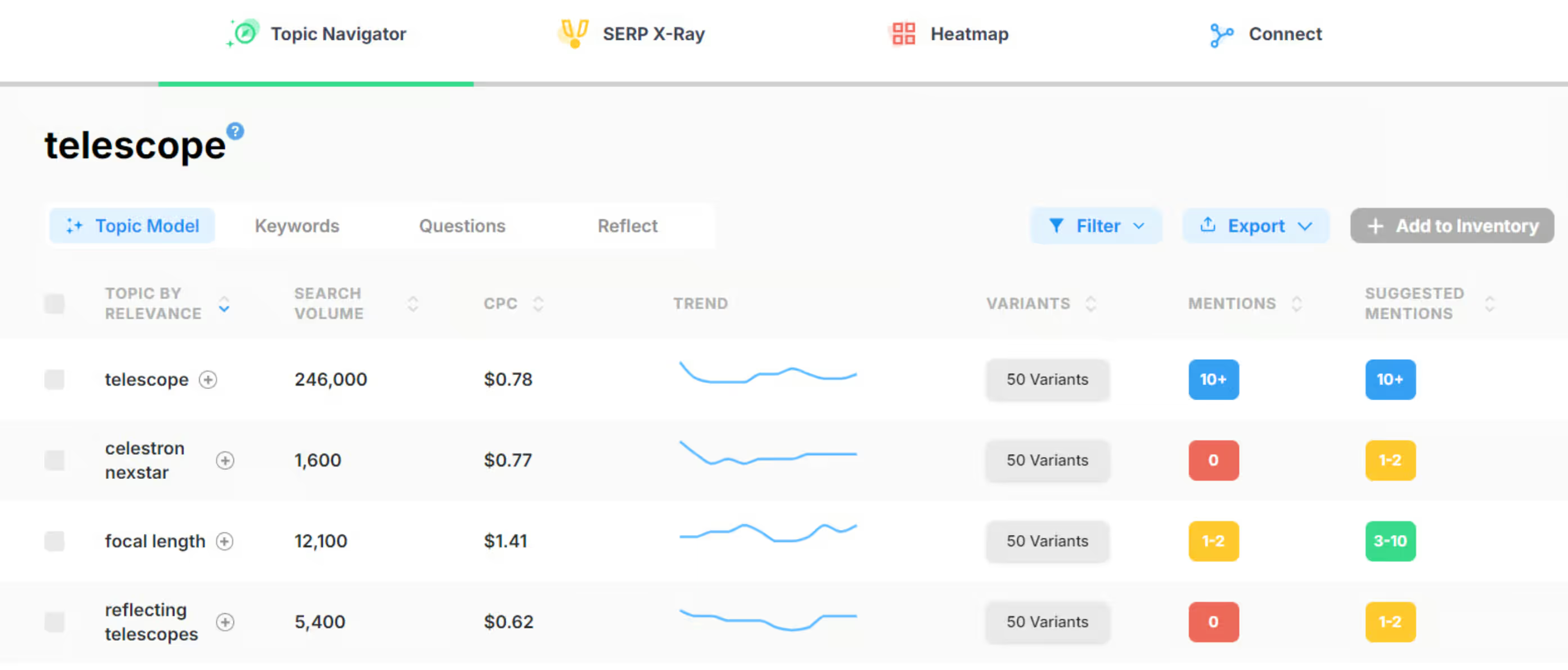
That strategic vantage point is its edge: you get a defensible plan for clusters, refreshes, and net-new pages, plus clear signals on effort vs. impact, including related keywords to optimize your strategy .
The trade-off is heaviness—there’s a steeper learning curve, a more complex interface, and pricing that fits teams treating SEO optimized content like a portfolio, not one-off posts.
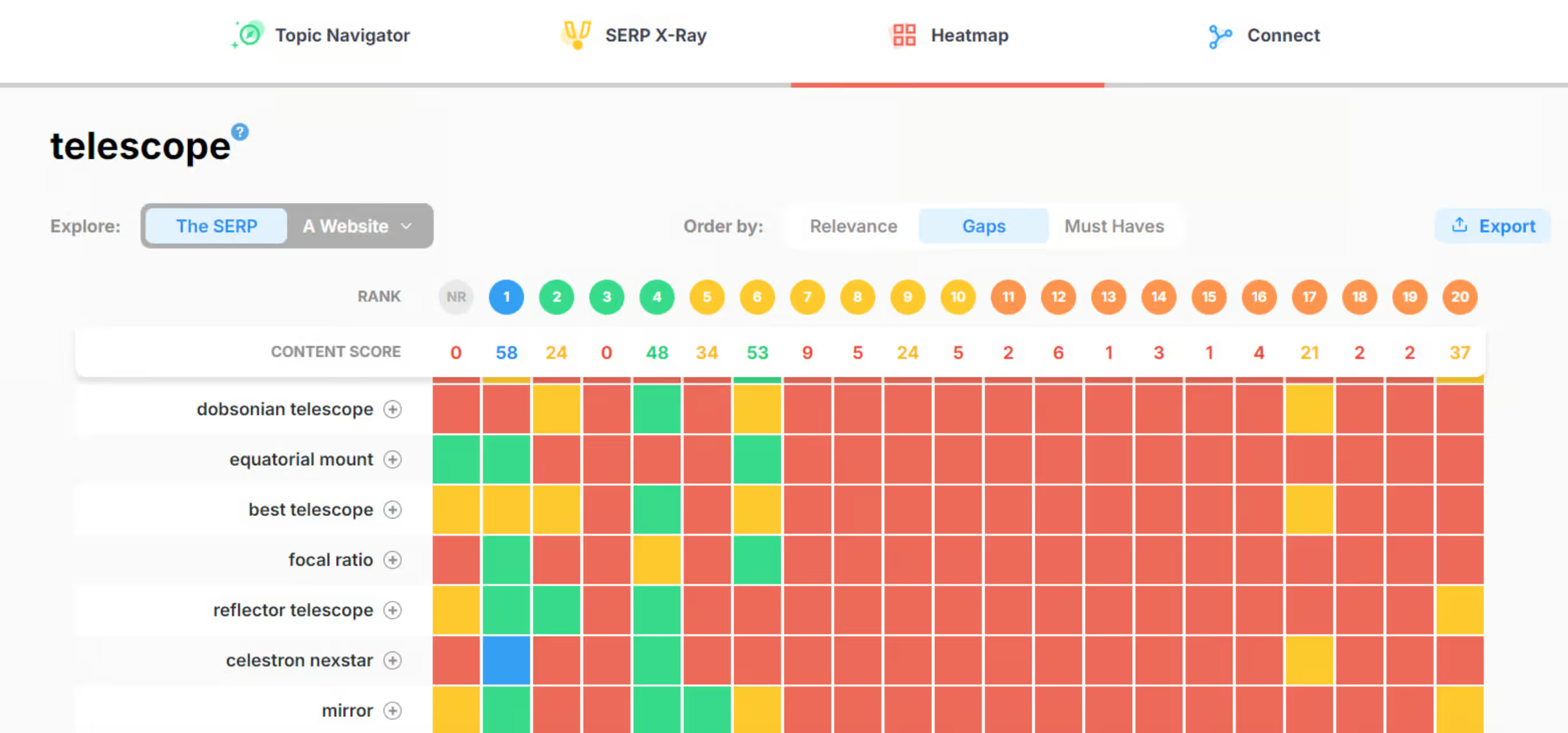
It also doesn’t mirror Dashword’s lightweight, in-editor handholding or provide automated internal linking and post-publish workflows out of the box, so you’ll likely pair it with an optimization/editor tool to execute.
Best for: Strategists and larger teams aiming to build topical authority at scale, when you need roadmap-level guidance rather than a faster way to write a single page.
4. Content Harmony
Content Harmony focuses on research depth and structured briefing rather than live, in-editor optimization.
Where Dashword provides a straightforward editor with keyword prompts, Content Harmony invests more in the front-loaded process, ensuring writers start with briefs that already account for keyword intent, competitor coverage, and audience questions.
Main features:
- Guided workflows for keyword research, content briefs, and draft preparation
- Content brief feature designed to support content writers by providing actionable data for optimizing content
- Keyword reports with search volume, CPC, difficulty, and intent signals
- Content grader to assess topical coverage and readability
- Research integrations that pull questions from Google PAA, Reddit, and Quora
- Built-in promotion workflows to generate supporting assets like social posts and emails
The strength here is consistency. For agencies or teams managing multiple contributors, standardized briefs mean writers don’t have to second-guess structure or intent.

It also digs deeper into audience insights than Dashword, surfacing niche questions and subtopics that make seo focused content more comprehensive.
Content Harmony integrates with your existing workflow, ensuring smooth collaboration between content writers and editors.
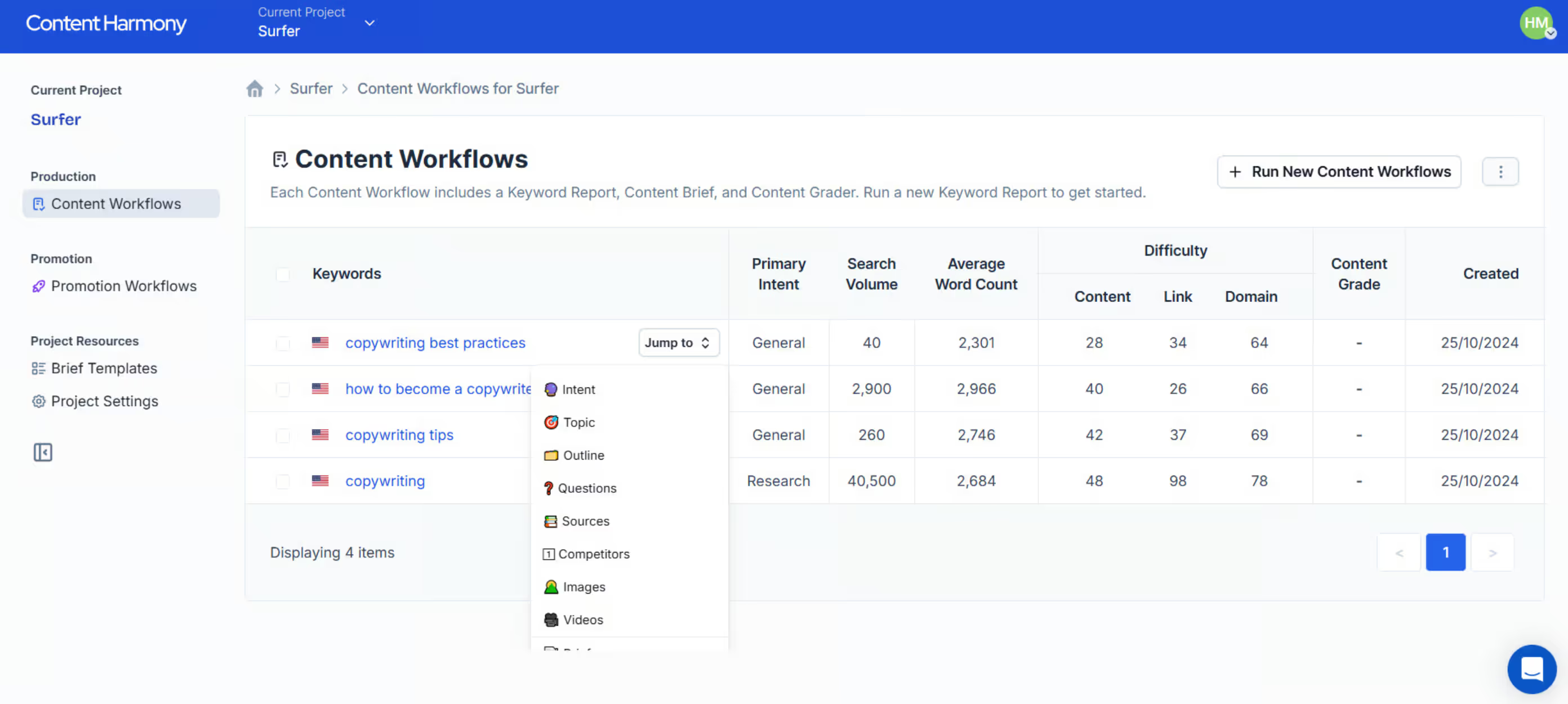
The trade-off is flexibility. Content Harmony doesn’t have the sleek, in-editor scoring of Dashword or the speed-to-draft of tools like Frase or Surfer. Nor does it offer automation around linking or post-publish analysis.
It’s best thought of as a research backbone: excellent for preparing content that’s aligned with search intent, but dependent on other tools to optimize and maintain performance after publication.
Best for: Teams that prioritize front-loaded research and standardized workflows to keep content quality and intent alignment consistent across writers.
5. Page Optimizer Pro (POP)
Page Optimizer Pro takes a very different approach than Dashword. Instead of focusing on clean briefs and simple keyword suggestions, it’s built for granular on-page SEO, giving practitioners detailed recommendations on how to structure and tweak pages to maximize ranking potential.
Main features:
- Automated SEO recommendations on keyword placement, word count, headings, and schema
- Competitor analysis comparing top-ranking pages at a structural level
- POP Watchdog to monitor SERP changes and ranking shifts after updates
- POP Schema tool for creating and implementing structured data
- EEAT evaluator to assess content and site signals for trustworthiness and authority
POP excels when you need precision over simplicity. The platform delivers actionable data to guide on-page SEO improvements, including a robust link manager for internal linking .
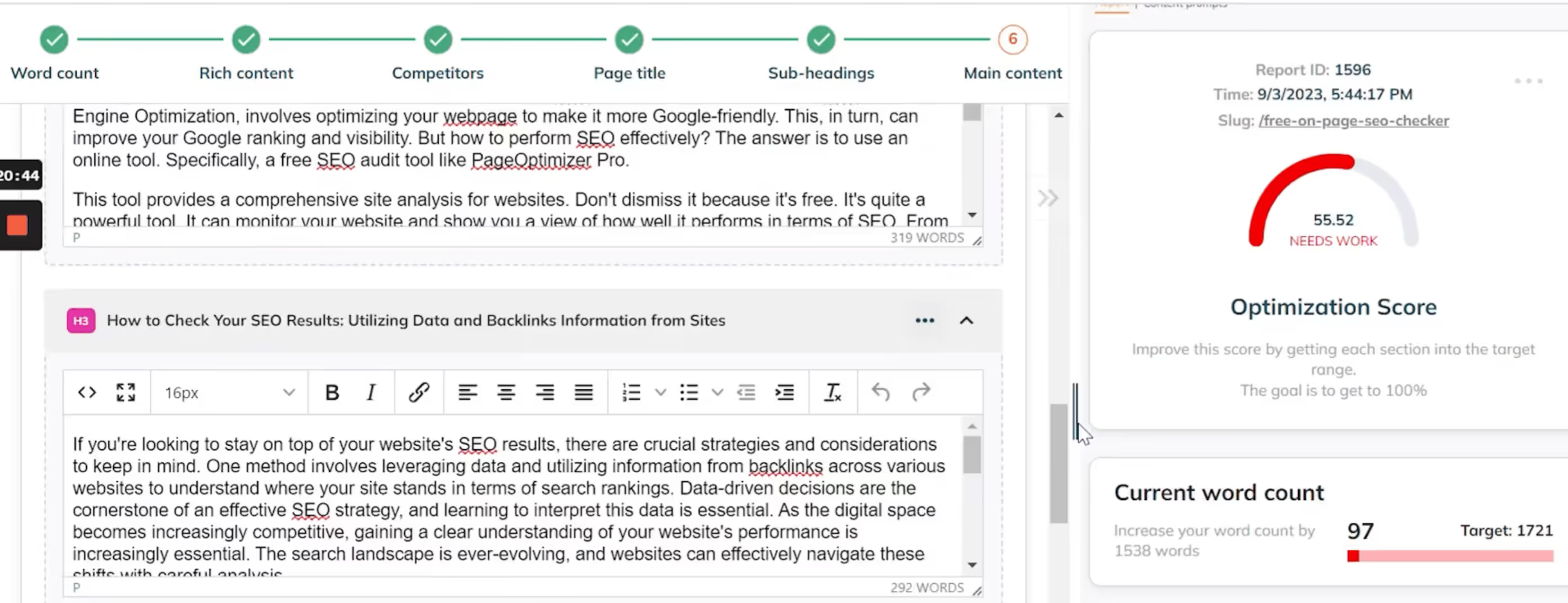
Its reports dig into schema usage, semantic terms, and competitor structures, offering insights that go far deeper than Dashword’s lightweight scoring. For technical SEOs and consultants, this level of detail can make the difference in competitive niches where fine-tuning matters.
The downside is usability. The interface isn’t as intuitive as Dashword’s editor, and there’s no AI drafting, internal linking automation, or collaborative workflow like Surfer.
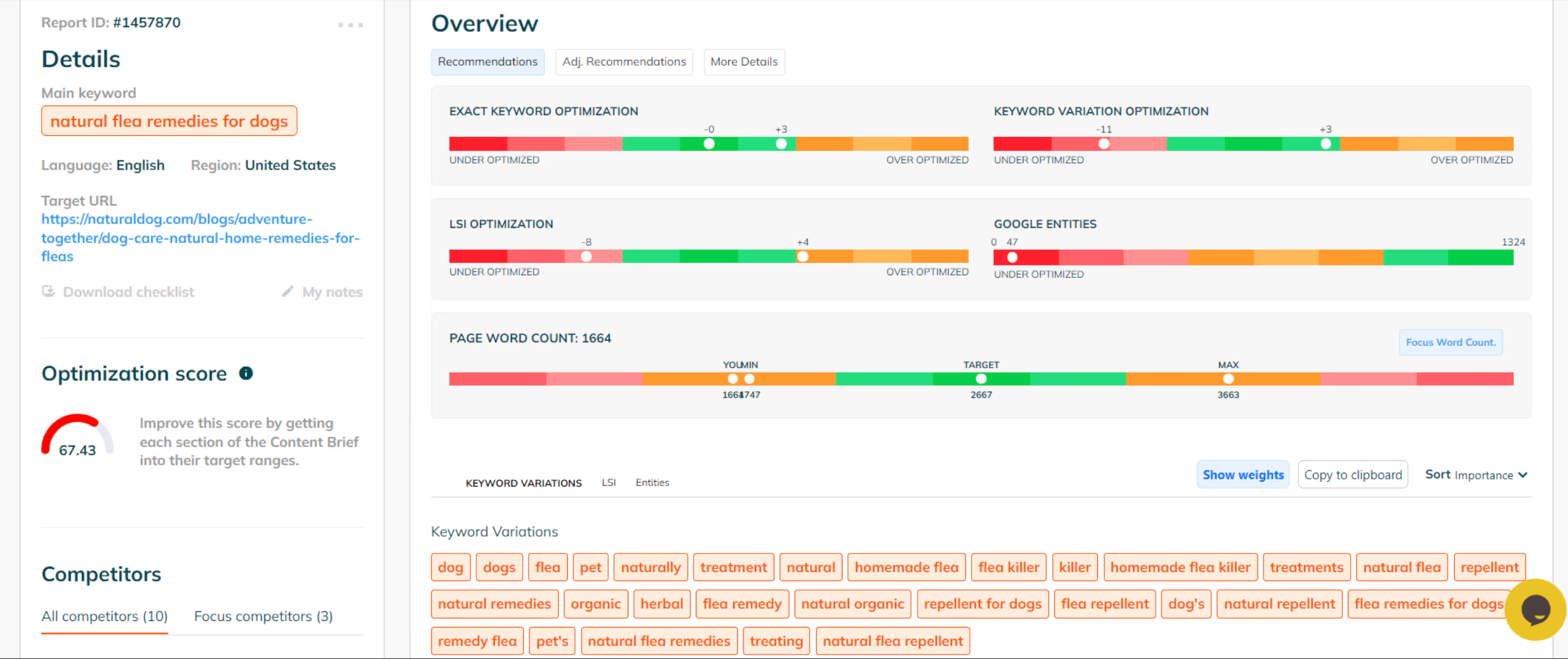
Writers who want a smooth, guided content process may find it overwhelming. POP is best suited as a diagnostic and optimization layer for those who already have a writing workflow in place.
Best for: SEO professionals and consultants who want in-depth on-page analysis and technical recommendations rather than a simple writing assistant.
6. Scalenut
Scalenut positions itself as an all-in-one AI SEO platform that blends keyword research, content planning, and optimization.
Unlike Dashword, which keeps things lightweight, Scalenut aims to cover the entire lifecycle—from strategy to writing to post-publish tracking.
Main features:
- Cruise Mode to generate SEO briefs and long-form drafts automatically
- Traffic Analyzer that connects with Google Search Console to monitor impressions, CTR, and rankings
- Content Optimizer for real-time guidance on keyword usage and structure
- Internal linking suggestions to strengthen clusters
- Free supporting SEO tools (e.g., sitemap generators, minifiers)
Scalenut stands out for its automation-first approach. Cruise Mode lets you spin up briefs and first drafts in minutes, integrating FAQs, keyword clusters, and suggested internal links, something far beyond Dashword’s simpler outlines.
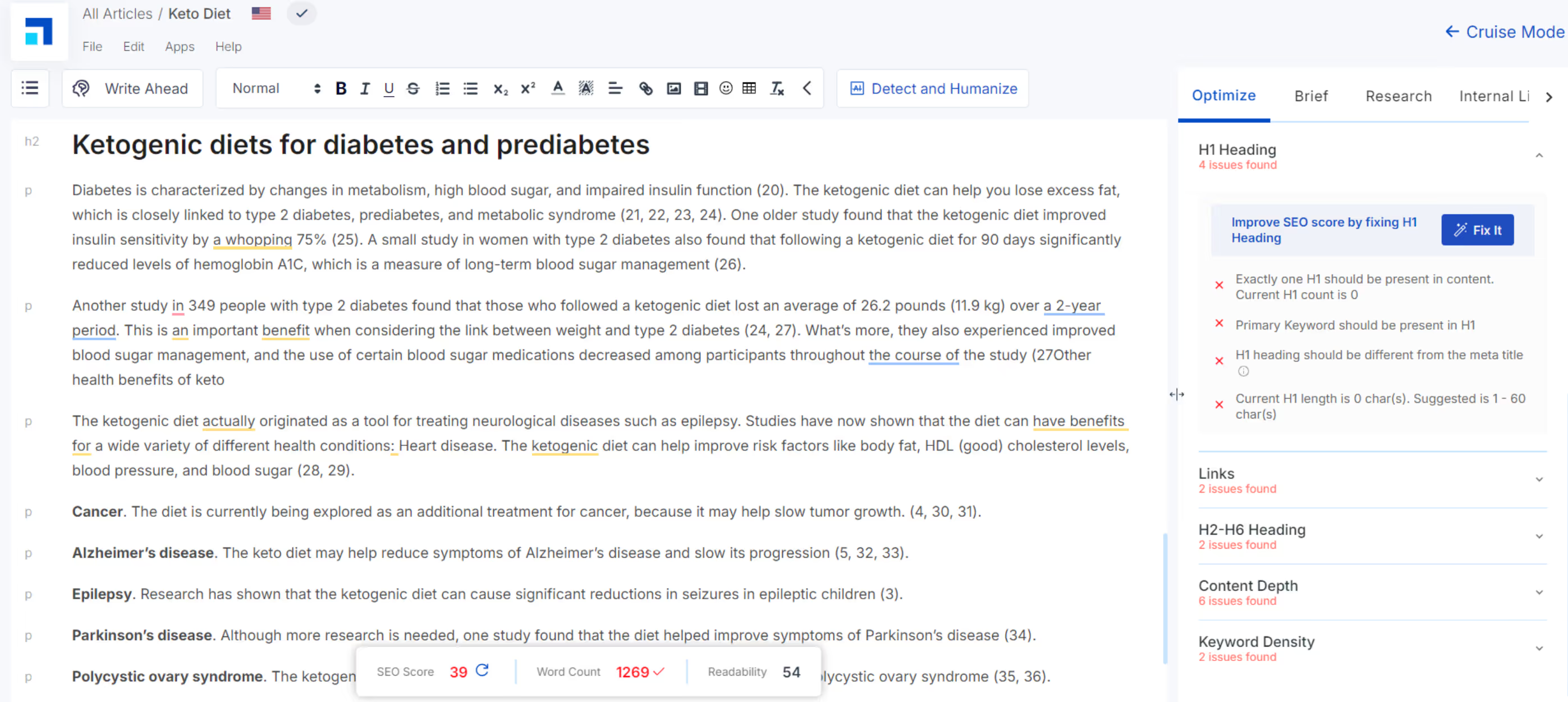
The Traffic Analyzer also adds visibility into how content performs once it’s live, which Dashword doesn’t address at all.
On the flip side, Scalenut’s interface can feel busy, with a steeper learning curve compared to Dashword’s clean editor.
Some workflows require moving between multiple modules, which slows things down if you’re only after quick optimizations.

Still, for teams that want scale and breadth in one platform, Scalenut offers more value than narrowly focused tools.
Best for: Content teams that need an affordable, AI-driven solution to plan, create, and optimize at scale.
7. Outranking
Outranking is built around AI-assisted research and drafting, giving teams a structured way to move from SERP data to optimized content.
While Dashword keeps its focus on simple briefs and live keyword prompts, Outranking layers in competitor-backed insights and AI-generated drafts to speed up production.
Main features:
- SERP analysis that extracts secondary relevant keywords, statistics, and content structures
- AI writing for titles, outlines, and full drafts informed by competitor data
- Content editor with keyword coverage, optimization score, and readability guidance
- Internal linking suggestions via Google Search Console integration
- Competitive analysis of how ranking pages are organized and optimized
The advantage of Outranking lies in its structured AI writing process. Instead of producing generic drafts, it uses SERP-driven insights to generate outlines and SEO optimized articles that mirror what’s working in search.
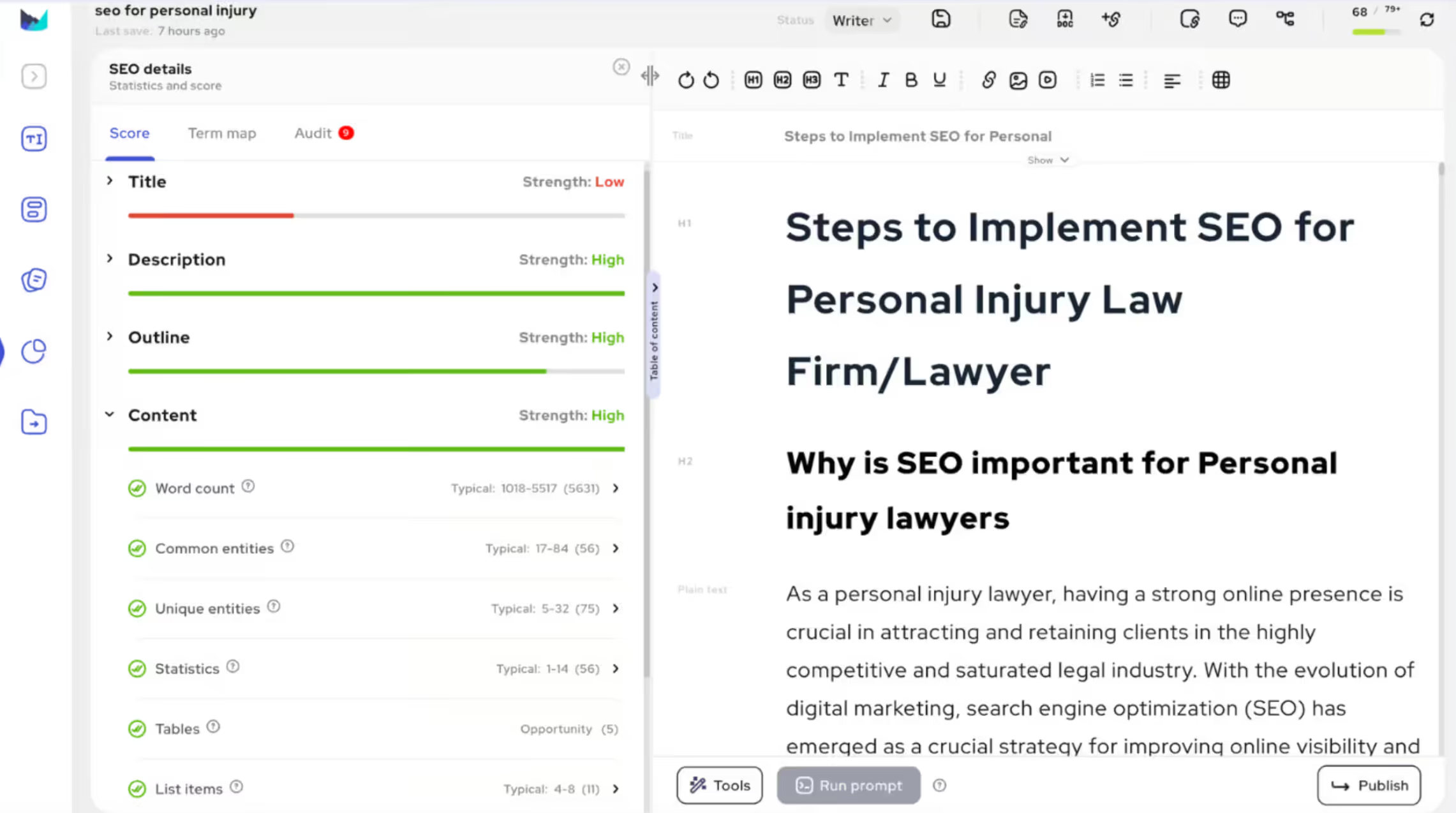
This gives it more depth than Dashword’s lean optimization approach. However, it’s not as lightweight. Setup takes more time, and the interface can feel dense compared to Dashword’s simplicity.
The AI outputs still need human editing to match brand voice and flow, which adds an extra step. Outranking works best for teams who want to accelerate content creation with AI while keeping it tied closely to competitive data.
Best for: Teams seeking an AI-powered workflow that blends research, drafting, and optimization to stay aligned with what already ranks.
8. Rankability
Rankability is a lightweight SEO content platform designed to keep optimization simple and accessible. Where Dashword offers a straightforward editor with keyword prompts, Rankability adds performance monitoring and a proprietary scoring system to show how well your content aligns with target terms, along with keyword recommendations .
Main features:
- Keyword research with filters for volume, CPC, trends, and difficulty
- Content editor to optimize drafts or imported articles
- Rankability Score to measure alignment with target keywords
- Visual content monitoring to track published pages against goals
- AI-powered brief generation with competitor-inspired outlines and FAQs
Rankability’s biggest strength is its clean, no-frills interface. It’s easy to move from keyword research to a brief to an optimized draft without the clutter of heavier platforms.
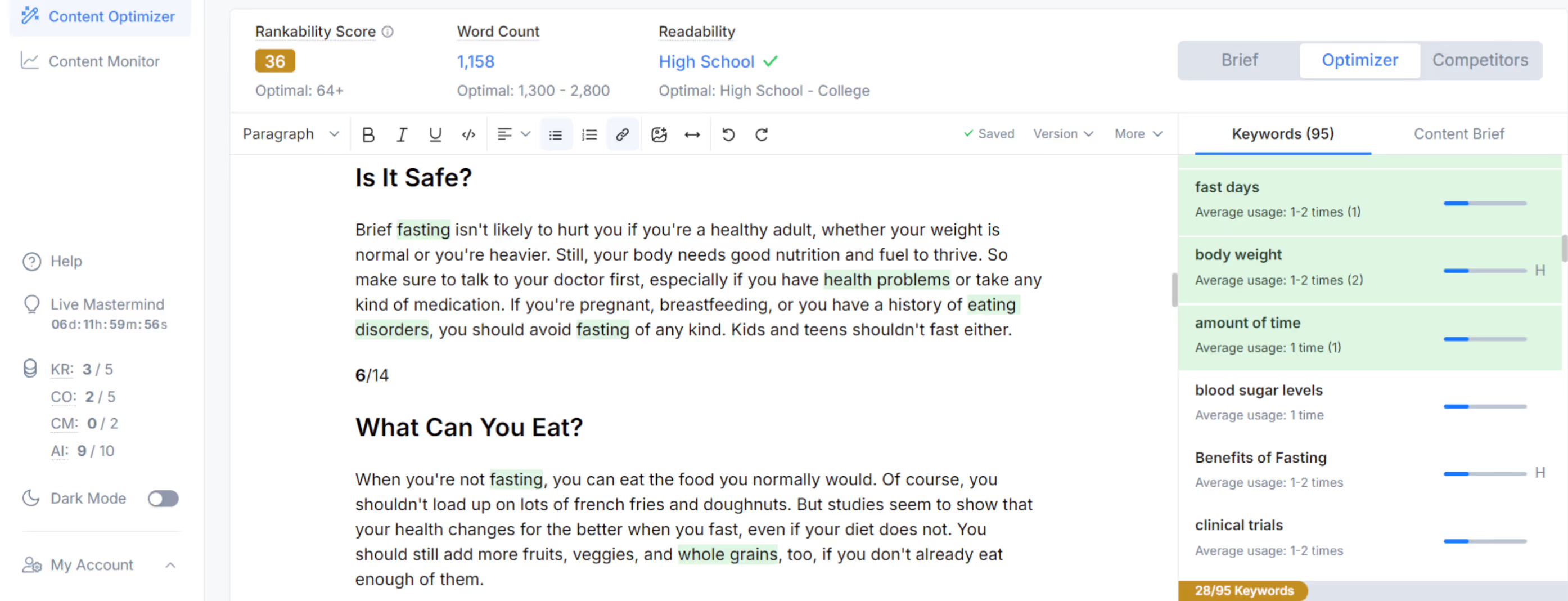
The performance monitoring also gives small teams visibility into whether their content strategy is working, something Dashword lacks. Rankability is especially suitable for small businesses due to its user friendly design, making it accessible for those with limited technical experience.
That said, Rankability is limited in scope. There’s no topic modeling, no internal linking automation, and its AI features stop at outline creation. The credit-based pricing model can also feel restrictive for teams producing high volumes of content.
It’s a solid step up from Dashword in terms of reporting and structure but doesn’t scale into advanced SEO territory.
Best for: Small teams and solo creators who want a beginner-friendly platform with straightforward editing and performance tracking.
9. Semrush Writing Assistant
Semrush Writing Assistant is part of the larger Semrush SEO suite, built as a lightweight optimization layer rather than a standalone platform.
Unlike Dashword, which centers around a dedicated content editor, Semrush Writing Assistant plugs directly into tools like Google Docs, WordPress, and Microsoft Word to provide SEO checks while you write. This integration allows users to optimize content within their existing workflow using a user friendly interface.
Main features:
- Integrations with Google Docs, MS Word, and WordPress
- Real-time SEO checks for keyword presence, headings, links, and alt text
- Content scoring across SEO, readability, tone, and originality
- AI writing assistant for rewrites and clarity improvements
- Built-in plagiarism detection
The appeal of Semrush Writing Assistant is convenience. For teams already using Semrush, it extends optimization directly into existing writing environments, reducing the need to switch platforms.
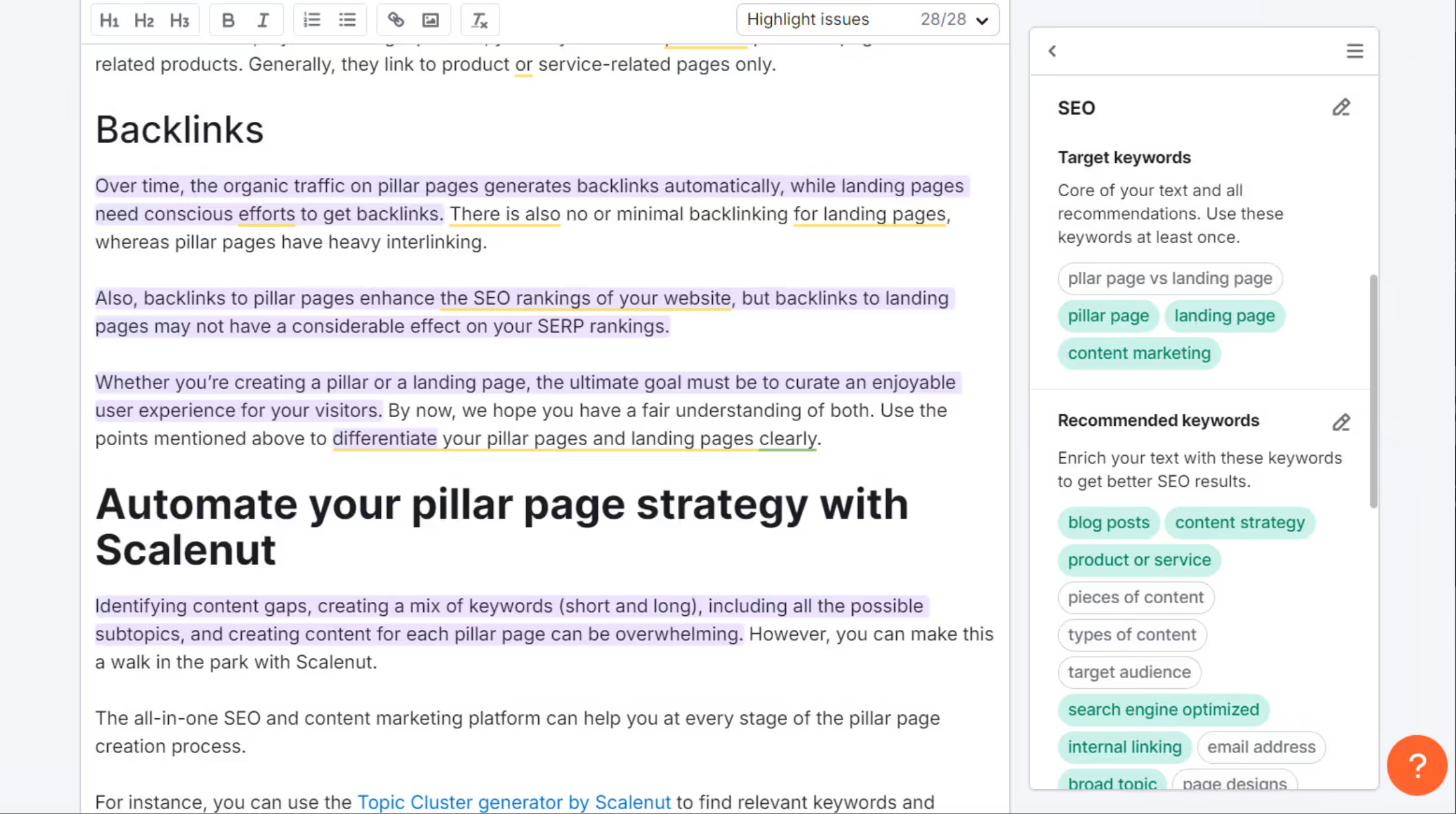
It’s especially useful for polishing drafts with keyword checks and readability guidance, making it a practical companion tool.
However, it doesn’t cover the full content workflow. Unlike Dashword, which handles briefs and outlines, Semrush Writing Assistant doesn’t generate structured content plans or provide deep SERP analysis.
It’s best thought of as an add-on for existing processes rather than a replacement for a full optimization platform.
Best for: Writers and marketing teams who want basic SEO and readability checks inside the tools they already use.
10. Jasper
Jasper is best known as an AI writing assistant rather than a pure SEO tool. While Dashword helps you structure and optimize content around SERPs, Jasper focuses on scaling content creation across different formats—blog posts, emails, ads, and social media—while keeping brand voice consistent.
Main features:
- AI-powered content generation for blogs, emails, ads, and more
- Brand Voice tools to ensure outputs match your style and tone
- Knowledge Hub for uploading brand guidelines, style docs, or reference material
- Campaign workflows for repurposing content across multiple channels
- Integrations with tools like Surfer, Webflow, and Zapier
Jasper’s biggest advantage is speed and versatility. Instead of focusing only on SEO, it’s built for teams that need to generate large volumes of branded content across different platforms.
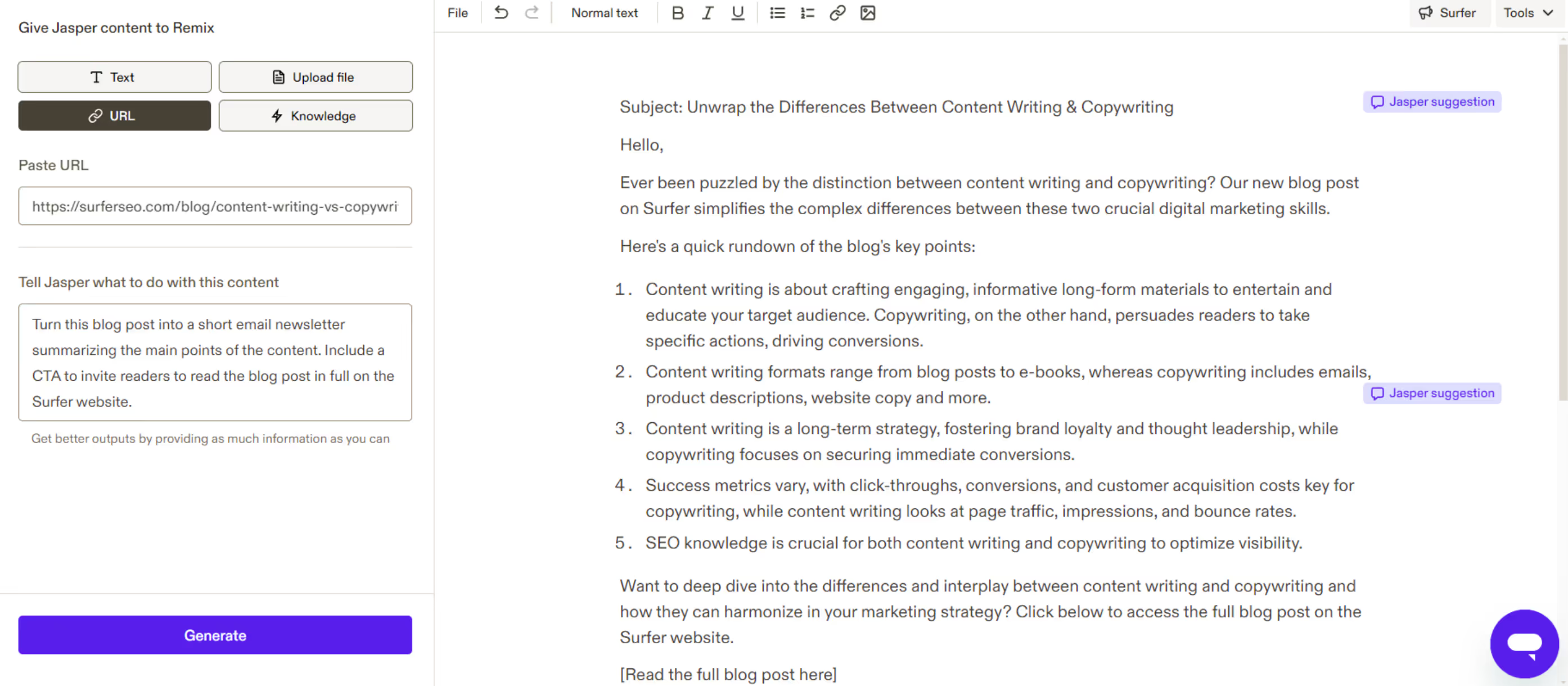
This makes it a broader solution than Dashword, which is strictly tied to content optimization.
However, Jasper doesn’t offer native SERP analysis, keyword scoring, or optimization workflows. Teams often end up pairing Jasper with a tool like Surfer to handle the SEO side.
It’s also prompt-driven, meaning quality depends heavily on how you guide it. For marketing departments that value brand cohesion and multi-channel campaigns, Jasper fills a gap that Dashword was never designed to cover.
Best for: Marketing teams and agencies that want AI-driven content at scale with consistent brand voice, and are willing to combine it with an SEO tool for optimization.
Dashword alternatives at a glance
Choosing the best Dashword alternative for your needs
The right Dashword alternative depends on your goals. If you only need to publish quickly, lightweight tools with auto-briefs and SERP analysis will cover the basics.
But for teams focused on rankings, topical authority, and adapting to AI-driven search, a more comprehensive platform is the smarter investment.
Surfer is the option that bridges that gap. It takes the ease of use that makes Dashword appealing and layers on strategy, automation, and ranking validation, so your content doesn’t just get published—it performs.
👉 Ready to move beyond Dashword’s limits? Start optimizing smarter with Surfer.
.avif)

